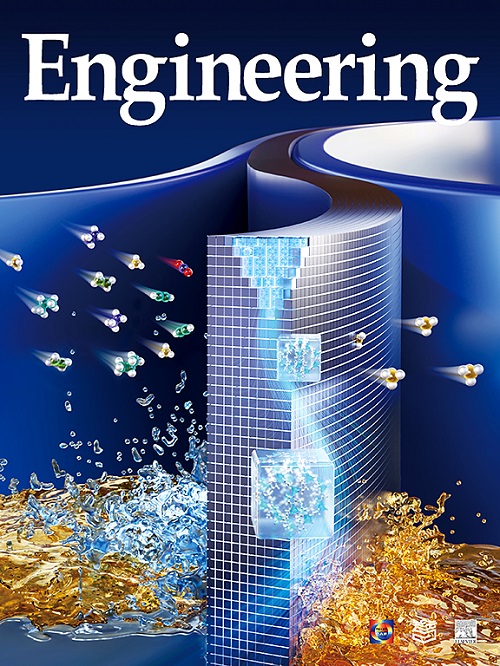通过精确的印模后修饰加入双共价受体的生物启发表面工程,提高对 5′-单磷酸腺苷的特异性识别能力
IF 10.1
1区 工程技术
Q1 ENGINEERING, MULTIDISCIPLINARY
引用次数: 0
摘要
扩大基底的比表面积和对印迹纳米腔进行精确的表面工程是提高分子印迹聚合物(MIPs)识别效率的重要方法。为了实现这种协同策略,生物启发表面工程通过精确的后印迹修饰(PIMs)将双共价受体整合到介孔二氧化硅纳米片上。制备的吸附剂(标记为“D-PMIPs”)用于提高对腺苷5 ' -单磷酸腺苷(AMP)的特异性鉴定。值得注意的是,介孔二氧化硅纳米片具有大约498.73 m2∙g-1的高表面积,这有助于在D-PMIPs中形成丰富的特异性识别位点。双共价受体通过多种协同相互作用对AMP的空间取向和排列具有重要意义。pim能够在印迹腔内实现精确的位点特异性功能化,从而形成量身定制的互补结合位点。D-PMIPs的最大高亲和力结合位点(Nmax)为39.99 μmol∙g-1,显著高于印迹单受体(S-BMIPs或S-PMIPs)。D-PMIPs的动力学数据可以用拟二阶模型有效地描述,表明其主要的结合机制是硼酸盐亲和和嘧啶碱的协同化学吸附。这项研究表明,使用双共价受体和pim是一种可靠的方法来创建高选择性的印迹吸附剂,允许对印迹位点进行控制工程。本文章由计算机程序翻译,如有差异,请以英文原文为准。
Bioinspired Surface Engineering with Dual Covalent Receptors Incorporated via Precise Post-Imprinting Modification to Enhance the Specific Identification of Adenosine 5′-Monophosphate
Expanding the specific surface area of substrates and carrying out precise surface engineering of imprinted nanocavities are crucial methods for enhancing the identification efficiency of molecularly imprinted polymers (MIPs). To implement this synergistic strategy, bioinspired surface engineering was used to incorporate dual covalent receptors via precise post-imprinting modifications (PIMs) onto mesoporous silica nanosheets. The prepared sorbents (denoted as “D-PMIPs”) were utilized to improve the specific identification of adenosine 5′-monophosphate (AMP). Significantly, the mesoporous silica nanosheets possess a high surface area of approximately 498.73 m2∙g–1, which facilitates the formation of abundant specific recognition sites in the D-PMIPs. The dual covalent receptors are valuable for establishing the spatial orientation and arrangement of AMP through multiple cooperative interactions. PIMs enable precise site-specific functionalization within the imprinted cavities, leading to the tailor-made formation of complementary binding sites. The maximum number of high-affinity binding sites (Nmax) of the D-PMIPs is 39.99 μmol∙g–1, which is significantly higher than that of imprinted sorbents with a single receptor (i.e., S-BMIPs or S-PMIPs). The kinetic data of the D-PMIPs can be effectively described by a pseudo-second-order model, indicating that the main binding mechanism involves synergistic chemisorption from boronate affinity and the pyrimidine base. This study suggests that using dual covalent receptors and PIMs is a reliable approach for creating imprinted sorbents with high selectivity, allowing for the controlled engineering of imprinted sites.
求助全文
通过发布文献求助,成功后即可免费获取论文全文。
去求助
来源期刊

Engineering
Environmental Science-Environmental Engineering
自引率
1.60%
发文量
335
审稿时长
35 days
期刊介绍:
Engineering, an international open-access journal initiated by the Chinese Academy of Engineering (CAE) in 2015, serves as a distinguished platform for disseminating cutting-edge advancements in engineering R&D, sharing major research outputs, and highlighting key achievements worldwide. The journal's objectives encompass reporting progress in engineering science, fostering discussions on hot topics, addressing areas of interest, challenges, and prospects in engineering development, while considering human and environmental well-being and ethics in engineering. It aims to inspire breakthroughs and innovations with profound economic and social significance, propelling them to advanced international standards and transforming them into a new productive force. Ultimately, this endeavor seeks to bring about positive changes globally, benefit humanity, and shape a new future.
 求助内容:
求助内容: 应助结果提醒方式:
应助结果提醒方式:


